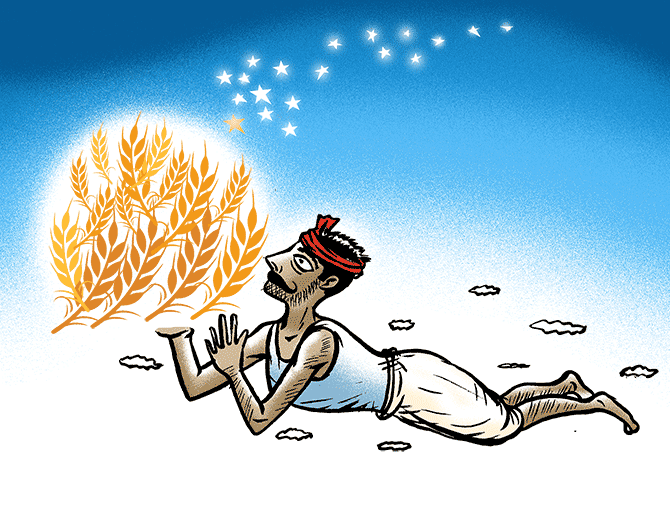 | « Back to article | Print this article |
Although demonetisation and improper implementation of GST along with falling prices are being blamed for much of the distress in rural India for some time, experts believe those may not be the only reason.
Illustration: Dominic Xavier/Rediff.com

Lakhichand Sinam of Sonee village in Mandsaur district, Madhya Pradesh, has for the first time seen his standing soybean crop being so badly destroyed by monsoon.
Not only his own crop, grown in over 4 acres, but almost the entire soybean crop in all the neighbouring fields has been damaged due to the incessant rain that broke several records this year, Sinam tells this reporter on phone from Mandsaur.
Soybean Processors Association of India (SOPA), in its last crop assessment report released on October 11, pegged the total soybean crop in Madhya Pradesh at more than 4 million tonnes, which is a drop of almost 31 per cent from the previous year.
The total production in the country has been estimated at 8.99 million tonnes, 17 per cent less than last year.
In any other time, such a sharp reduction in production would have pushed up prices in the spot market.
But, this year is not like any other.
While a decline in international soyoil and soymeal prices is a reason for weakness in soybean prices, poor economic sentiment in rural India stands out as a key trigger.
In fact, revealing a severe slowdown, a Nielsen report a few days ago had pointed at a seven-year low in rural FMCG (fast moving consumer goods) growth in the September quarter.
FMCG growth numbers are typically a measure of the overall economic sentiment.
So, it was no surprise that data sourced from agmarket.nic.in showed soybean rates in Indore markets consistently dropping since the first week of October.
On October 17, it was quoting at around Rs 3,500 per quintal, against the 2019-20 Minimum Support Price (MSP) of Rs 3,710 per quintal.
Even future pricing doesn’t look too bright.
Barring momentary spikes here and there, overall sentiment in rural economy remains very weak, according to Mahendra Dev, director of Mumbai-based Indira Gandhi Institute of Development Research (IGIDR).
"How long this will continue is difficult to say because global food prices are still stagnant and demand is absent,” said Dev.
D N Pathak, executive director of SOPA, holds the international scenario responsible for the domestic slide.
“When the demand for end product, be it soyoil or soymeal is down internationally, why would domestic bean prices improve,” he said.
Wage issue
Almost in sync with the rural consumption slowdown, agriculture wages too are going downhill.
Labour bureau data shows that growth in real wages for rural male general agriculture workers decelerated to (minus) 3.4 per cent in July.
The consumer price inflation for agriculture workers during the same month was 6.21 per cent against 2.04 per cent a year ago.
“This clearly shows that while wages of rural workers are declining, the prices of items he buys are rising, thereby hitting him hard,” a senior official said.
Although demonetisation and improper implementation of Goods and Services Tax (GST) along with falling prices are being blamed for much of the distress in rural India for some time, experts believe those may not be the only reason.
“A big part of rural demand and consumption in the last few years was supported by debt as in every state farmers were taking more loans than (what was) needed for agriculture.
"And this could not have gone on for long," NITI Aayog member and eminent agriculture economist Ramesh Chand told Business Standard.
"At some stage, this debt-laden growth had to end, and the impact of which is showing up,” he pointed out.
The contrarian signal
While most indicators from rural India point towards a deepening crisis, the latest Gross Value Added (GVA) for agriculture and allied activities for the April to June quarter of 2019 presents a rather contrasting picture.
The difference between real and nominal GVA in agriculture and allied activities for Q1 2019-20 - which sometimes gives a broad idea of farmers’ income – was at a 11-quarter high of 5.9 per cent.
This was the highest level since the third quarter of 2016-17, coinciding with demonetisation.
Meanwhile, the government’s own spend in rural areas in the current financial year has seen an increase.
In two of these signature projects - MGNREGA and PM-KISAN - funds directly pass on to end beneficiaries.
In the case of MGNREGA, official data shows that between April and September, Central release for wages and materials was around Rs 48,397 crore, almost Rs 4,630 crore more during the same period last year.
But, not all of it may have reached the end beneficiary because of usual delays after the Central release of funds.
Under PM-KISAN, a sum of around Rs 15,600 crore has already been pumped into rural hands this financial year through the Rs 2,000 installments.
As P K Joshi, former South-Asia Director of International Food Policy Research Institute (IFPRI), puts it, in the case of PM-KISAN disbursement, timing matters a lot in making any tangible impact on rural sales.
A quick pilot study done by IFPRI in few select districts of Uttar Pradesh showed that when the ~2,000 installment of PM-KISAN was given ahead of sowing season, farmers used it for buying fertilizer and seeds, which got reflected in their increased sales, Joshi said.
"It is only when the installment was given between sowing seasons, farmers spent it on FMCG goods.”
And, this time, rains have not helped.
“It (the surplus rains) could have some positive impact on rabi crops, but overall the rains haven’t done much to alleviate distress in rural areas,” Shashank Bhide of Madras Institute of Development Studies (MIDS) said.